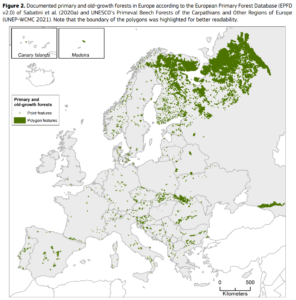Where to find old growth forests?
The answer to this simple question is not as clear as one might think. We still lack robust data about strong criteria to qualify a forest of “old-growth” and on the history of some forests. What is certain, is that the largest area of old-growth forest cannot be found in Europe… According to the World Database on Protected areas, worldwide, there remains 11.1 million km2 of old-growth forests, of which 61% are located in Canada, Brazil and Russia. In 2009 only 21% of the original old-growth forests could be found all over the world. Of these, 35% are found in South America in the Amazon rainforest in Brazil; 28% in North America, especially Canada and Alaska; and 19% in North Asia, where the world’s largest boreal forest is located. In addition, only 8% is found in Africa, partly due to the timber industry. Then 7% in South Asia-Pacific where the forests are being destroyed at the highest rate compared to any other ecosystem in the world. Finally, Europe has less than 3% of the world’s remaining old-growth forests and more than 150 km2 are being cleared each year.
https://www.worldatlas.com/articles/old-growth-forests.html
https://www.worldatlas.com/articles/old-growth-forests.html

More details about where to find old-growth forests
Old-growth forests in Europe are rare, small and fragmented. Without human intervention, Europe would have been completely covered with old-growth forests. In Europe, only 3% of the world’s forest area is covered. Since the Holocene, forests have been exploited for human activities such as cropland and pasture, a source of building material, a source of fuel,…
The exact surface of all the old-growth forests in Europe together is unprecedented. 90% of the forests in Europe are in Sweden, Bulgaria, Finland and Romania. At the moment there is a lack of mapping in different European regions, so it becomes difficult to have a complete picture of the amount and location of old-growth forests. This limitation also affects the less strict protection, less managed buffer zones, less connectivity, and reduced conservation measures in these areas.

JRC Publications Repository – Mapping and assessment of old-growth and old-growth forests in Europe (europa.eu)
https://publications.jrc.ec.europa.eu/repository/bitstream/JRC124671/maes_policy_narrative_old-growth_old_growth_forests_-_report_v4.0_pdf_2.pdf
The exact surface of all the old-growth forests in Europe together is unprecedented. 90% of the forests in Europe are in Sweden, Bulgaria, Finland and Romania. At the moment there is a lack of mapping in different European regions, so it becomes difficult to have a complete picture of the amount and location of old-growth forests. This limitation also affects the less strict protection, less managed buffer zones, less connectivity, and reduced conservation measures in these areas.

JRC Publications Repository – Mapping and assessment of old-growth and old-growth forests in Europe (europa.eu)
https://publications.jrc.ec.europa.eu/repository/bitstream/JRC124671/maes_policy_narrative_old-growth_old_growth_forests_-_report_v4.0_pdf_2.pdf
The world’s oldest and most beautiful old-growth forests are located on different continents. Let’s discover some of them below!
Tarkine is an old-growth forest located in Tasmania in Australia. It is one of the world’s most threatened and largest temperate rainforests. It is home to the oldest living organism on earth, the giant Huon pine. This tree is known as being able to reach the age of 3000 years, but science has never been able to confirm this myth. The oldest Huon pine we know is 1774 years old. The Tarkine forest also provides habitats for the Tasmanian devil.
Yakushima is an old-growth forest located on the Osumi Islands in Japan. It is a paradise for almost 2000 plant species, including the Yakusugi, also called the Japanese cedar.
Tongass National Forest is an old-growth forest located on Prince of Wales Island in Alaska. This old-growth forest is the largest national forest in America with almost 7 million hectares. This huge area comprises coastal forests, coastal mountains with icefields, and large areas of tundra.
Kakamega Forest is an old-growth forest located in Kakamega in Kenya. It was once one of the largest old-growth forests on the planet. Now the old-growth forest is fighting for survival due to the impact of man (logging). There are still some 300 bird species, the Colobus monkey and 700-year-old fig trees.
Białowieża Forest is an old-growth forest located in Poland and Belarus. This last old-growth forest in Europe is only 580 square kilometres in size, but it contains trees that are thousands of years old. The fauna is remarkable, as the European bison is found there (1,500 are still alive).
Piovesan, Biondi; On tree longevity, New Phytologist, 2020
https://www.smithsonianmag.com/travel/amazing-old-growth-forests-world-180956083/?page=1
Tarkine is an old-growth forest located in Tasmania in Australia. It is one of the world’s most threatened and largest temperate rainforests. It is home to the oldest living organism on earth, the giant Huon pine. This tree is known as being able to reach the age of 3000 years, but science has never been able to confirm this myth. The oldest Huon pine we know is 1774 years old. The Tarkine forest also provides habitats for the Tasmanian devil.
Yakushima is an old-growth forest located on the Osumi Islands in Japan. It is a paradise for almost 2000 plant species, including the Yakusugi, also called the Japanese cedar.
Tongass National Forest is an old-growth forest located on Prince of Wales Island in Alaska. This old-growth forest is the largest national forest in America with almost 7 million hectares. This huge area comprises coastal forests, coastal mountains with icefields, and large areas of tundra.
Kakamega Forest is an old-growth forest located in Kakamega in Kenya. It was once one of the largest old-growth forests on the planet. Now the old-growth forest is fighting for survival due to the impact of man (logging). There are still some 300 bird species, the Colobus monkey and 700-year-old fig trees.
Białowieża Forest is an old-growth forest located in Poland and Belarus. This last old-growth forest in Europe is only 580 square kilometres in size, but it contains trees that are thousands of years old. The fauna is remarkable, as the European bison is found there (1,500 are still alive).
Piovesan, Biondi; On tree longevity, New Phytologist, 2020
https://www.smithsonianmag.com/travel/amazing-old-growth-forests-world-180956083/?page=1
